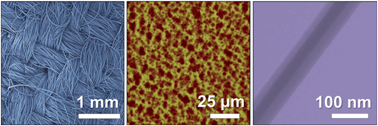The combination of appealing structural properties, biocompatibility, and the availability of renewable and inexpensive raw materials, make keratin-based materials attractive for a variety of applications. In this paper, we report on the antimicrobial functionalization of keratin-based materials, including wool cloth and regenerated cellulose/keratin composite films and nanofibers. The functionalization of these materials was accomplished utilizing a facile chlorination reaction that converts the nitrogen-bearing moieties of keratin into halamine compounds. Halamine-charged wool cloth exhibited rapid and potent bactericidal activity against several species of bacteria and induced up to a 5.3 log (i.e., 99.9995%) reduction in the colony forming units of Bacillus thuringiensis spores within 10 min. Keratin-containing composites were prepared by the spin coating and coaxial electrospinning of extracted/oxidized alpha-keratin and cellulose acetate (CA) solubilized in formic acid, followed by CA deacetylation. Regenerated cellulose/keratin materials chlorinated to display halamines were also effective in killing Escherichia coli and Staphylococcus aureus bacteria. Electrospun core/shell nanofibers engineered to maximize keratin-Cl surface area displayed higher activity against S. aureus than films composed of the same materials. The halamine-based antimicrobial functionalization methods demonstrated for keratin-based materials in this paper are anticipated to translate to other protein biopolymers of interest to the biomaterials community.

You have access to this article
 Please wait while we load your content...
Something went wrong. Try again?
Please wait while we load your content...
Something went wrong. Try again?


 Please wait while we load your content...
Please wait while we load your content...